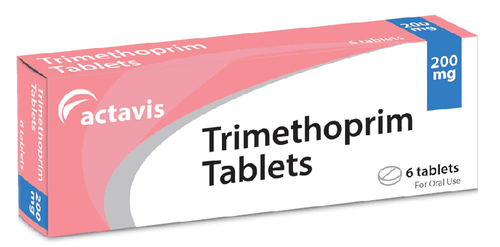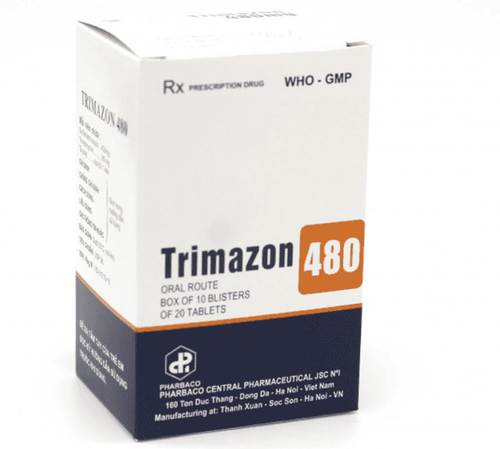This is an automatically translated article.
Trimazon 240 belongs to the group of antibiotics, which is a combination of Sulfamethoxazol and Trimethoprim, effective in treating infections caused by bacteria sensitive to Cotrimoxazol. Using Trimazon 240 exactly as prescribed by your doctor will help you ensure your health and maximize the effectiveness of your treatment.
1. What is Trimazon 240?
Trimazon 240 has the main ingredient Sulfamethoxazole combined with Trimethoprim to form Cotrimoxazol, a broad-spectrum anti-infective, antifungal and protozoan drug. The specific uses of each ingredient in Trimazon 240 are:
Sulfamethoxazole is a sulfamethoxazole derivative of pyrimidine with broad antibacterial spectrum, effective against many gram-negative and positive aerobic bacteria such as Staphylococcus, streptococcus, N. gonorrhoeae, E. coli, Salmonella,... Trimethoprim has bacteriostatic effect, inhibits bacterial dihydrofolate- reductase enzyme, helps fight urinary tract bacteria and coliforms. Thanks to the effect of inhibiting 2 consecutive stages of folic acid metabolism, Trimazon 240 effectively inhibits the synthesis of purine, thymine and eventually bacterial DNA. Trimazon 240 is usually indicated in the following cases:
Gastrointestinal infections: E. coli diarrhea, Shigella bacillus dysentery, second-line drug in the treatment of typhoid. Upper and lower respiratory tract infections: pharyngitis, otitis media, acute pneumonia, exacerbation of chronic bronchitis, pneumonia. Uncomplicated lower urinary tract and genital tract infections, bacterial prostatitis. Purulent skin infections, wound abscesses. Dental and periodontal infections. Contraindications of Trimazon 240 include:
Children under 2 months of age. Premature babies. Patients with known hypersensitivity to any of the components of Trimazon 240 Patients with severe renal impairment, plasma concentrations of the drug cannot be monitored. The patient has liver parenchymal damage. Megaloblastic anemia due to folic acid deficiency.
2. Dosage of Trimazon 240
Depending on the subjects and treatment goals, the dosage of Trimazon 240 will be different, specifically as follows:
Uncomplicated lower urinary tract infections:
Adults: 800mg Sulfamethoxazole + 160mg Trimethoprim, how 12 hours apart for 10 days or a single dose of 320mg Trimethoprim + 1600mg Sulfamethoxazole for a minimum of 3 or 7 days. Children: 8mg Trimethoprim/kg + 40mg Sulfamethoxazole/kg given in 2 doses 12 hours apart, for 10 days. Chronic recurrent urinary tract infections (adult female):
Low doses of 200mg Sulfamethoxazol + 40mg Trimethoprim per day or 2-4 times more, taken once or twice a week have been shown to be effective in terms of work. reduce the number of relapses. Respiratory tract infections:
Exacerbation of chronic bronchitis: 800-1200mg Sulfamethoxazole + 160-240mg Trimethoprim, 2 times daily for 10 days. Acute otitis media, acute pneumonia in children: 8mg Trimethoprim/kg + 40mg Sulfamethoxazole/kg in 24 hours, divided into 2 times, 12 hours apart, for 5-10 days. Strep throat: do not take this medicine Gastrointestinal tract infections:
Bacillary dysentery adults: 800mg Sulfamethoxazole + 160mg Trimethoprim 12 hours apart, for 5 days. Bacillary dysentery in children: 8mg Trimethoprim/kg + 40mg Sulfamethoxazole/kg in 24 hours, divided into 2 times 12 hours apart, for 5 days. Pneumocystis carinii pneumonia:
Children and adults both recommend a dose of 20 mg trimethoprim/kg + 100 mg sulfamethoxazole/kg in 24 hours, every 6 hours, for 14-21 days When an overdose of Trimazon 240 will cause manifestations of anorexia, nausea, vomiting, headache, unconsciousness and blood regenerative disorders, jaundice in the late stage. Necessary management of poisoning is induction of vomiting, gastric lavage, and acidification of urine to increase elimination of trimethoprim. If there are signs of myelosuppression, patients should take Leucovorin (folinic acid) 5-15 mg/day until hematopoietic recovery.
3. Side effects of Trimazon 240
In some patients when using Trimazon 240 may experience side effects such as:
Fever. Nausea, vomiting, diarrhea, glossitis. Itching, skin rash, urticaria. Anaphylactic reaction. Toxic epidermal necrolysis, Steven-Johnson syndrome, erythema multiforme, angioedema, photosensitivity. Megaloblastic anemia, hemolytic anemia, thrombocytopenia. Aseptic meningitis. Jaundice, hepatic cholestasis, hepatic necrosis. Illusion. Renal failure, interstitial nephritis, kidney stones. Tinnitus.
4. Be careful when using Trimazon 240
Some general notes when using Trimazon 240 include:
Patients with impaired renal function are prone to folic acid deficiency (elderly people and long-term use of high doses of Cotrimoxazol), causing dehydration, malnutrition . Cotrimoxazole may cause hemolytic anemia in G6PD-deficient people. Sulfonamides can cause jaundice in perinatal infants by pushing bilirubin out of albumin. Because Trimethoprim and Sulfamethoxazol can interfere with folic acid metabolism, the drug should be used during pregnancy only when clearly needed and most importantly, folic acid should be added. Cotrimoxazole should not be used by nursing mothers because infants are very sensitive to the toxic effects of the drug. The above is information about the uses, dosage and precautions when using Trimazon 240. To ensure safety for your health and maximize the effectiveness of your treatment, you need to use Trimazon 240 exactly as directed by your doctor. doctor.
Please dial HOTLINE for more information or register for an appointment HERE. Download MyVinmec app to make appointments faster and to manage your bookings easily.













